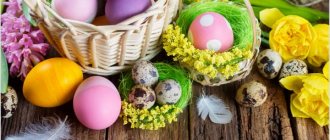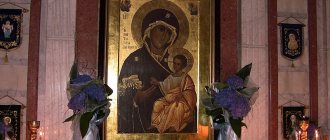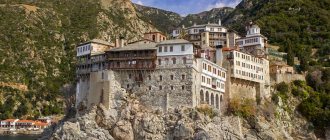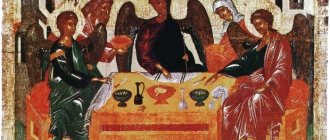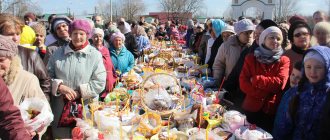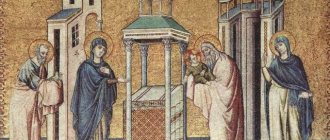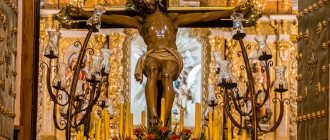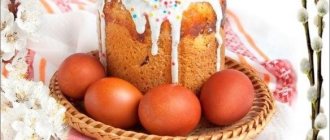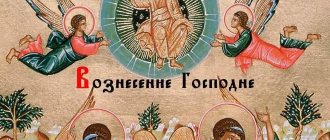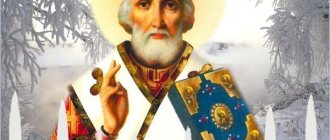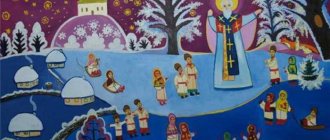Also one of the Russian Easter traditions is Christening. This is a special Easter greeting when Orthodox Christians greet each other by saying “Christ is Risen!” and “Truly he is risen!” It is noteworthy that such a greeting was previously used for 40 days, until the Feast of the Ascension.
In Rus', it is customary to break the fast during the service: there are Easter cakes, Easter cottage cheese and eggs. In general, the Easter table in Rus' was always quite rich, since Lent ended. Easter cakes symbolized eternal life and prosperity. Holiday bread has always been consumed by Orthodox Christians at Easter. Among other things, it is customary to paint eggs for Easter. There are many versions of the origin of this tradition. One of them says that after the resurrection of Christ, Magdalena came to Emperor Tiberius. She said “Christ is Risen!” and handed him a simple egg as a modest gift. But Tiberius was not impressed by the gift and Fr. Then the egg turned red. In memory of this miracle, eggs began to be painted in Rus'.
Currently reading:
- When is Honey Savior in 2022: holiday traditions and how to celebrate. When you can and cannot eat honey
- Why is Cat Day celebrated on March 1, who came up with this unusual holiday?
In Rus', natural dyes were used to color eggs. Onion peels were most often used. Eggs painted in this way came in a variety of shades, from yellow to terracotta. Also, some eggs were painted, and therefore received the name “pysanka”. Among other things, decorative eggs were made from beads and wood. The famous Faberge eggs are an example of decorative Easter eggs.
Easter has always been accompanied by folk festivities and fun
The holiday of the Resurrection of Christ has always been associated with the victory of life over death and good over evil. It also represents the end of Lent, one of the strictest fasts for Orthodox Christians.
Therefore, in addition to a sumptuous meal, folk festivities were traditionally held on Easter. The next Sunday after Easter, a holiday called “Red Hill” was held. In Rus', this holiday was accompanied by round dances, dances, matchmaking and folk festivities. Girls and boys who had reached marriageable age were supposed to take part in these festivities. It was after “Red Hill” that believers got married, as this time was considered the most favorable.
Also, the festive events lasted throughout the bright week after Easter. A popular game was egg rolling, which was popularly called “rolling”. Painted wooden eggs were rolled down a slide or wooden board to knock down other eggs. The goal of the game was to knock down as many eggs as possible. If the egg was successfully knocked down, the participant took it for himself and continued the game. If not, another participant began to play, and the unsuccessfully rolled egg remained on the line.
Easter: traditions, customs and rituals
Easter is celebrated by the entire Christian world, regardless of religion. Only each religion has its own traditions, customs and treats. Let's talk today about how Easter is celebrated here and in other countries.
Easter is celebrated by the entire Christian world, regardless of religion. Only each religion has its own traditions, customs and treats. Let's talk today about how Easter is celebrated here and in other countries.
Easter in Russian
Since ancient times in Russia, Easter was celebrated widely, generously, tables were set for 48 dishes, the main of which, naturally, were colored eggs , Easter cakes and cottage cheese Easter.
In rich houses, they painted up to 1000 eggs, so that there would be enough for all household members and all employees. The biggest and most beautiful Easter stayed at home, and the smaller ones went to neighbors and friends; They donated eggs and Easter to hospitals, monasteries and almshouses, and they always treated the servants in the servants' quarters.
On this day there were no class and social differences, the boundaries between classes were erased, and universal grace came.
Now, like several centuries ago, they begin to prepare for Easter in advance. On Maundy Thursday, they must clean houses and apartments, get rid of trash, wash windows and wash themselves. Trim hair, mustaches and beards; If there are small children in the house, then it is best to cut their hair for the first time on Maundy Thursday.
It is believed that before Easter it is no longer possible to pick up rags and a broom, which is why housewives are trying to prepare the house for the holiday. In the evening, the whole family paints eggs and bakes Easter cakes, prepares Easter cottage cheese with raisins and nuts. All work must be done before 12 am, so everyone helps - both children and men.
On Saturday, all Easter treats are taken to the church, where the priest will bless them. And on Sunday, joyful, well-dressed people sit down at laid tables and congratulate each other on the Holy Resurrection of Christ.
How to set a holiday table
Russian people love to eat deliciously, so for any holiday they try to set a generous and beautiful table, pampering their guests and themselves. And, as they say, God himself commanded to make the Easter table magnificent.
Do you want your table to be special? Decorate it with an Easter meadow. You still have time to grow your little meadow - a symbol of the coming spring and prosperity.
Take a wide bowl or dish, pour a couple of centimeters of earth on the bottom and throw oat grains into it (you can use dill, parsley, lawn grass). Pour until a paste forms and place the dish on the windowsill, closer to the sun.
For Easter, place painted eggs, ribbons, flowers on your lawn, plant toy chickens or birds baked from dough. Place the composition in the center of the table.
If you are too lazy to fuss with the soil and planting, or you simply don’t have time to germinate the grains before Easter, buy a large bunch of dill and use it to make a soft backing for eggs and decorations.
By the way, greenery and flowers are a mandatory attribute of Easter; in the old days, artificial flowers were made from colored paper and scraps, devoting long winter evenings to this process. Icons, Easter cakes, and plates around Easter were decorated with these flowers, so Easter tables were bright and beautiful.
We can talk endlessly about our original Easter traditions, but let's see how it happens for others. The most interesting customs for you.
Passover - Jewish Passover
Jewish Passover is a topic worthy of a separate treatise. To be honest, if you are not a devout Jew, then many of those traditions will seem strange to you, but everyone has their own canons.
Let's start with the fact that Passover is celebrated for 7 days, and in Israel the first and last days of Passover are official non-working days, that is, you won’t even buy bread there, not to mention visiting all sorts of institutions. By the way, they don’t eat rich bread on Passover, only matzo, which is prepared in advance and in large quantities.
And on the first and last day of Passover, devout Jews not only have no right to do household chores, but even to light a fire - the Torah does not command.
Before the holiday, all trash is thrown out of the house, not a single crumb of so-called chametz should remain on the floor or in the house in general - anything that has been fermented, kneaded and fermented (bread, pasta , cookies, etc.) - they are checked for the presence of prohibited products all the cracks. Moreover, in our time, it is possible to store someone else’s chametz in the house, so neighbors often share with each other everything that falls under this category - both the traditions are respected and the property is not damaged.
And according to the canons, chametz can be sold to a non-Jew through the mediation of a rabbi, put it in a box and kept as someone else’s property, and after Passover ends, buy it back. True, there is a danger that the new owner will lay claim to the chametz. This happens when chametz is alcohol made from grains.
Another tradition symbolizing the exodus of the Jews from Egypt, dipping greens and eggs in salt water is a symbol of Jewish tears.
Signs
Easter, like any other major holiday, is rich in customs and signs:
- Cool weather, but without frost, means a dry summer, and cold weather means a good harvest.
- If there is thunder and a thunderstorm on Easter, autumn will be dry and late.
- If it is cloudy on a holiday Sunday, it means cold summer.
- A sunny day means a warm and fruitful summer.
- You should not throw away garbage after sunset before Easter - you may lose your luck along with it.
- If crumbs of blessed Easter cake or Easter are fed to the birds, then there will be money all year long.
- If on a festive Sunday a girl’s eyebrows itch, she will soon meet her chosen one and get married.
- If on Easter, after the consecration, you distribute some of the attributes to the poor, your well-being will certainly improve.
- If a woman dreams of having a child, she needs to place an additional plate with Easter cake and a colored egg on the Easter table.
- If a baby is born on Easter, he will be happy, healthy and famous.
- In order to have financial well-being, it is necessary for all family members to go to church for a service, and then immediately return home for the morning holiday meal.
- If you watch the sunrise on Easter, troubles will bypass your home for the whole year.
- In order for the cake to turn out fluffy and tasty when baking, the house should be quiet and calm.
- Broken dishes at Easter mean illness and troubles in the family.
This is only a small part of the signs that have survived and survived to this day.
What not to do on Easter
There are a number of things that are not recommended to do on Easter. Many plans can and should be postponed to other days. Not recommended for Easter:
- work on the land (dacha, garden);
- cut hair;
- go to the bathhouse;
- clean the home;
- remember the dead;
- go to the cemetery;
- have sex;
- sew, wash;
- to be sad, to quarrel;
- swear, gossip;
- hunt for fun;
- get married in a church.
There is no strict prohibition on cleaning the house, but if possible, it is better to refuse all work on this day and devote it to celebrating Easter.
What is possible
Easter is a great holiday and therefore most of the restrictions of fasting lose their force. Those who observed fasting break their fast on this day immediately after the end of the festive service.
The priests recommend doing what brings joy and satisfaction. It is necessary to communicate with loved ones and friends, to share with them the joy of the Risen Christ.
The Easter Bunny and Other Catholic Customs
Our eggs are laid by chickens, while for Catholics they are laid by hares. That’s why the baskets that are given to children for Easter are called “rabbit” baskets.
However, the kids do the same thing with these eggs as ours do - they roll them across the lawns and down the hill - whoever rolls farthest is the lucky one. Another fun Catholic Easter tradition is that adults hide colorful eggs around the house and garden, and children have fun looking for them - this is called an Easter Bunny hunt. It is also customary to give children plush and clay bunnies.
Confectioners and chocolatiers also do not miss their profits - they make hares from marzipan and chocolate, bake cookies in the shape of bunnies, and even create entire hare families framed by sweet eggs - such compositions decorate tables in Catholic homes.
In Poland, they “bury” Lenten soup and hang boring herrings, that is, they hang them on trees. Can you imagine the smell?
In England, children throw raw eggs into a sieve with names written on them - whose egg lasts longer than others wins, and a gift and happiness awaits him.
In Switzerland, Easter eggs are hung on trees around rivers and streams . From a distance, these trees resemble New Year trees with abundantly hung toys.
Easter beliefs
Easter: traditions, customs and rituals
But let's return to Russia. Despite the fact that Easter is a church holiday associated with true faith, Russians would not be Russians if Easter Sunday had not been surrounded by popular beliefs and superstitions. For example:
- On Easter night, after the religious procession had taken place and the bells had fallen silent, people in the villages locked themselves at home and were afraid to go out even in great need. It was believed that at this time evil spirits were “walking”, demons crawled out of their hiding places and lay in wait for people to prevent them from celebrating Easter morning;
- on Easter itself, colored eggs were rolled over livestock to keep cows and horses smooth and healthy;
- housewives hid all consecrated food from mice so that, having tasted it, they would not turn into fliers - a symbol of death;
- on Saturday evening, at the intersection closest to the village, they rolled eggs in different directions so that the devils would not find their way to this village, they would only dance at the intersection until they dropped, and then disappeared, without bringing hunger, pestilence, disease and loss of livestock to the village;
- when washing on Maundy Thursday, coins of the largest denomination available in the house were dipped into a tub of water; it was believed that in this way wealth was “washed”, although according to the canons it was not recommended to touch money - in memory of the silversmiths of Judas;
- The bravest ones, after the religious procession, tried to secretly hide in the church in order to see the deceased behind the flame of a candle. This was especially true for brides who had lost their grooms;
- The most touching belief made old people dream of death during Easter week. It was believed that these days no one guards the gates to heaven, so they can easily get to heaven.
What Easter traditions do you have?
Nadezhda POPOVA
Easter traditions
Easter is the main Orthodox holiday, the day of the Resurrection of Christ. This year Easter falls on April 16th according to the new style.
Easter service
In Rus', the Resurrection of Christ was always celebrated in church. The Easter service is the most solemn of the year. The service begins before midnight. The Midnight Office is served until 24 o'clock, during which the priest and deacon go to the Shroud, incense it, lift it and take it to the altar. At about midnight, Easter Matins (or Matins) begins. An integral part of the Easter service is the procession around the temple. When believers enter the temple, the singing of the canon of St. John of Damascus begins. Matins ends with the reading of the catechetical word for Easter by St. John Chrysostom. After Matins, the Hours and Liturgy are celebrated with the royal doors open. They remain open throughout Bright Week as a sign that Christ has forever opened the gates of the Kingdom of Heaven to all Christians.
History of the holiday in Russia
In pre-revolutionary Russia, Easter was a public holiday; the first days of Bright Week were non-working days. After the October Revolution of 1917, the situation began to change due to the fight against religious prejudices. The holiday itself was celebrated, but only Easter Sunday itself and the following Monday remained as days off. In 1928, all days of Easter week became working days. There was no official ban on the celebration, but the authorities tried to replace Easter with secular events, for example, meetings of communist youth (known as “red Easters” or “Komsomol Easters”). It was unsafe for parishioners to openly attend church services; this could become grounds for dismissal from work, as well as criminal prosecution for political reasons.
The Soviet authorities allowed believers to openly celebrate the holiday only once, after the start of the Great Patriotic War. On the night of April 5, 1942, the curfew in Moscow was lifted. Easter services were held in the capital and region, which, according to the Moscow NKVD department, were attended by 85 thousand people. Divine services also took place in besieged Leningrad and in some other cities and towns of the country.
The unspoken ban on celebrating Easter remained for the next 40 years. At the end of the 1980s, on the eve of the 1000th anniversary of the baptism of Rus' (1988), a revision of state policy regarding the church and the rights of believers began. On the night of April 7, 1991, the first television broadcast of the main Easter service was organized from the Epiphany Cathedral in Elokhov, located in Moscow (since 2001, these services have been held in the Cathedral of Christ the Savior). On April 18, 1993, Russian President Boris Yeltsin attended Easter celebrations for the first time. Since then, attendance at Easter services by top officials of the state has become a tradition.
What types of Easter eggs are there?
There are several traditional types of Easter eggs.
Painted eggs (or galunkas) are eggs painted in one color (mostly red), without a pattern applied to the shell. Since ancient times, natural dyes, primarily onion peels, have been used to prepare dyes. With its help, a rich terracotta color and yellow of varying intensity were obtained.
Pysanky are eggs painted with traditional folk ornaments or patterns (mostly geometric or floral). In V. Dahl’s explanatory dictionary you can find the following definition: “Pysanka is an Easter egg painted with different colors in a pattern: it is written with a wire hook, which is dipped in wax; when put in paint, it is painted only on the spaces.” Easter eggs were painted only raw; they were not eaten. After Trinity, it was customary to blow out such eggs. A painted egg was turned into a bird by gluing wings to the shell.
The egg had to be painted using a special technology, following the rules for combining the colors of the ornament and background.
If these rules were violated, then the egg no longer became a pysanka, but a little one. This means that they applied not a traditional pattern to it, but their own.
Specks are eggs with a plain background on which patterns of stripes or spots are applied.
Another type is rags, or scraps. After dyeing such eggs, a certain pattern was scratched on their shell.
Eggs are decorative eggs made from wood, beads and other materials. The famous Faberge eggs can also be considered a variety of them.
USA (America)
In the USA there is a wide range of Easter celebrations, which can be divided into church and secular ones. The former include worship services, masses, vigils, sunrise services, and food illumination. The second - multi-scale shows - America is literally boiling with parades, carnivals, and festivals. Even hunting is officially permitted in parks – within the boundaries of populated areas. Symbolic prey for both adults and children are surprise eggs scattered in the grass. The more you collect (the clock is set on a timer, the excitement is off the charts), the more goodies you get - each one is filled with sweets.
The presidential orchestra is playing on the south lawn of the White House, and an animator bunny invites children to a national competition (broadcast live on a national channel) - rolling wooden Easter eggs with a kitchen spatula.
Park bowling alleys with giant pins and egg balls are open all over the country. Funny Easter bunnies read Bible stories to children, conduct paid photo sessions, master classes on holiday crafts in the style of different eras, and actively invite them to take part in entertaining quests.
Manhattan is full of breathtaking outfits and fantastic headdresses - the Hat Parade takes place here every year. Thousands of Americans from all states and districts are participating in the flash mob.
Family dinners are a key part of the celebration. There is no strict set of Easter dishes, but most likely on the tables you can see ham baked in glaze, “cross” buns stuffed with raisins, apples with cinnamon, chocolate, and oranges. A special place is also given to Easter bread with marshmallows in the center, lamb served in the form of kebab or chops, gingerbread and cookies in the form of an eared symbol of Catholic Easter.
Where did this tradition come from?
The tradition of giving each other colored eggs on the day of the Resurrection of Christ spread thanks to Mary Magdalene.
Mary was the first to whom Christ appeared after his Resurrection and said: “Do not touch Me, for I have not yet ascended to My Father; But go to My brothers and say to them, “I am ascending to My Father” (John 20:17). Mary Magdalene brought the good news to the Apostles that she had seen the Lord. This was the first sermon about the Resurrection.
When the Apostles dispersed from Jerusalem to preach to all corners of the world, Mary Magdalene also left with them. Even before the Apostle Paul, a woman went to Rome, the center of the then civilization. The brave disciple of Christ even appeared to Emperor Tiberius and told about the life, miracles and teachings of Christ, about how He was slandered by the Jews and crucified by the verdict of Pontius Pilate.
The Emperor doubted the story of the Miracle. Then Mary Magdalene took a white egg, which she brought to the palace as a gift, and with the words “Christ is Risen!” gave it to Tiberius. Before the eyes of the Roman ruler, the egg turned from white to bright red.
In the library of the monastery of St. Anastasia the Patternmaker, located in the northern part of Greece, near the city of Thessaloniki, a handwritten Greek charter of the 10th century has been preserved. It contains a prayer read on Easter Day for the blessing of eggs and cheese. The abbot, distributing the consecrated eggs, says to the brethren: “This is how we received it from the holy fathers, who preserved this custom from the very times of the apostles, for the holy Equal-to-the-Apostles Mary Magdalene was the first to show the believers an example of this joyful sacrifice.”
Table decoration
Easter includes traditions and customs associated with the table, but in this case not with dishes, but with decoration and serving. Since the holiday falls in the spring, it is advisable that a bouquet of fresh flowers or a woven wreath be placed at the head of the table. You can place flowers in a prominent place in the house.
For a bouquet or wreath, it is better to use wildflowers. The truth of the holiday is that we pay tribute to God, and not in a luxurious way. With simple actions we show the joy of spring, which has defeated the harsh winter. A person should behave modestly and be simple.
Folk traditions of celebrating Easter
The first Sunday after Easter is called Antipascha, and popularly – Red Hill . In Rus', it has always been a day of youth celebrations, round dances and matchmaking. Girls and boys who had reached marriageable age were supposed to take part in these festivities. According to church traditions, starting from Krasnaya Gorka, believers can get married.
A favorite Easter pastime was egg rolling , or "rolling". The games began on the first day of Easter and sometimes continued throughout Bright Week. One game could last several hours. Wooden, skillfully painted eggs were often used, and sometimes entire sets of such eggs were prepared especially for the game.
The riding rules were as follows. The painted egg was rolled down an inclined wooden plank or along the ground - from a slight hill. Below, all the participants in the fun placed other eggs in a semicircle, one each. The goal was to knock the egg out of place. If this worked, the participant took the beaten egg for himself and continued the game. If he missed, the next participant entered the game, and the unsuccessfully rolled egg remained on the line.
Canada
The harsh climate and mix of cultures have transformed the holiday traditions of Canadian Easter, giving it more spring motifs than religious ones - people crave fun. And the leitmotif of the two official weekends - Sunday and Monday: family vacation, fun, games, drive with full blast.
Tons of chocolate bunnies and eggs are sold - with and without filling - symbols of prosperity, thousands of lilies - purity. Having exchanged baskets of gifts, Canadians rush into the streets - into a whirlpool of celebrations: an exciting egg hunt, a dance party of thousands - a festival of very free morals with a frantic pace of electronic music and a bright light show. The most famous and large-scale takes place in Montreal.
On the Vancouver Islands they organize Easter beach parties. A grand parade is taking place in Toronto, attracting tens of thousands of fellow citizens - a mix of traditional paraphernalia led by a rabbit, assorted cosplays, festively decorated antique cars, marching musicians, sports schools, clowns and cartoon characters.
In Vegreville, Ukrainian folk songs are heard around a giant pysanka (a symbol of Canadian unity). In Halifax, Scottish bagpipes are singing, couples are circling in the ri.
Theatrical performances “with the Passion of Christ” take place everywhere, and at the festive tables the hosts treat guests and loved ones to cross-shaped buns dipped in glaze, lamb ham, Easter curds in the shape of a dove, and cakes made from 33 thin cakes (according to the number of earthly years lived by the Son of God).
Japan
“Harisutosu fukkatsu,” Japanese Christians greet each other on Easter, and in response they hear: “Jitsu-ni fukkatsu.” They go to Orthodox churches, bless colored eggs for Easter and ritual baked goods, and after the Easter liturgy and procession they celebrate the celebration with their community or (as in China) in the family circle.
Every year on the eve of Christ's Resurrection, cherry blossoms bloom in Japan. Its branches are used to decorate houses and decorate gifts. Even on eggs, Japanese housewives depict delicate spring flowers. Modern children who participate in egg painting prefer drawings from anime - an innovation that has recently crept into the almost two-century history of Japanese Easter.
In addition to traditional Easter cakes - thickly flavored with candied fruits and honey, on the Japanese table these holidays there are dishes of quail and pheasant, chicken on skewers, grilled beef, and beans.
Africa
African Easter is a cocktail of humility, religious jubilation and frantic energy. The holy day is celebrated in South Africa, Ethiopia, Cameroon, Tanzania, Uganda, Nigeria, Ghana, and Kenya. All canonical traditions are observed: from fasting, church services and masses, to family meals with ritual dishes.
And yet the African temperament and mobility take their toll - Africans are already singing and dancing in temples. Choral singing is in the blood of all the peoples of the hot continent.
It is impossible to imagine the inhabitants of the Dark Continent without colorful carnivals. Ritual performances last until midnight. Moreover, group dances have a clear purpose - from spells, praise to the gods to appeals to the spirits of fertility. Dancers wearing masks, helmets, headbands and colorful ethnic costumes fall into a trance.
A special Easter dish is spicy chicken baked in coals. People also enjoy a spicy casserole made from minced beef and fruit, and banana muffins.
Mexico
Mexican Easter - Semanta Santa (a week before the solemn day of the Resurrection - Mexicans “torture” themselves with strict obedience and even torture) and Semena de Pascua (Easter week). All state-owned enterprises and schools are closed - people participate in religious celebrations, theatrical performances, and glorify Christ.
In addition to religious experiences, they have fun, have fun, and go to carnival processions. The latter are held with pomp - costumes, fiery dances, life-size puppets, masks, fireworks - until the morning.
Instead of the European knocking of eggs, there is a tradition of smashing them on each other's heads. The eggs are not simple - filled with confetti painted in sacred colors. The essence of “beating” is to shower a person from head to toe, so that happiness, health and all sorts of good things accompany him all year long.
The Mexican Easter menu includes dishes of lamb's heads stuffed with liver, crispy lamb tongue croquettes, and unleavened tortillas fried in oil. Dessert – chocolate Easter figures, rainbow gelatin eggs, pudding with cheese, nuts and pieces of fruit.
Australia
Easter on the Green Continent falls in the spring and at the beginning of the autumn season. Anglicans, Lutherans, and Catholics go to churches, have Sunday Easter meals with relatives, and exchange Easter gifts in the form of chocolate eggs and animals. Interestingly, the European Easter Bunny is increasingly transforming in Australia into the rarest rabbit bandicoot, living only on this continent - the cute, long-eared, marsupial Bilby.
Vacations and four-day weekends that fall on holidays are full of outdoor picnics, fairs, folklore, and blues festivals. Sports competitions are especially popular: horse racing, yacht racing, football battles, and diving.
Sydney hosts the Royal Easter Show with a unique interactive exhibition of birds and animals - farm and domestic. You can pet them, cuddle them, cut them, milk them... There are pavilions with Easter treats everywhere, as well as attractions and concert venues. There is a rodeo, circus performances, arm wrestling and wood chopping competitions. The culmination is a costumed grand parade and a giant fireworks display.
The Australian Easter menu includes sugar buns with the image of a cross (Easter breakfast starts with it), a bright meringue cake with slices of kiwi, pineapple, and strawberries. Hot appetizers are in use: fried beef and lamb, beans, broccoli, chicken with potatoes and carrots, baked pumpkin.
